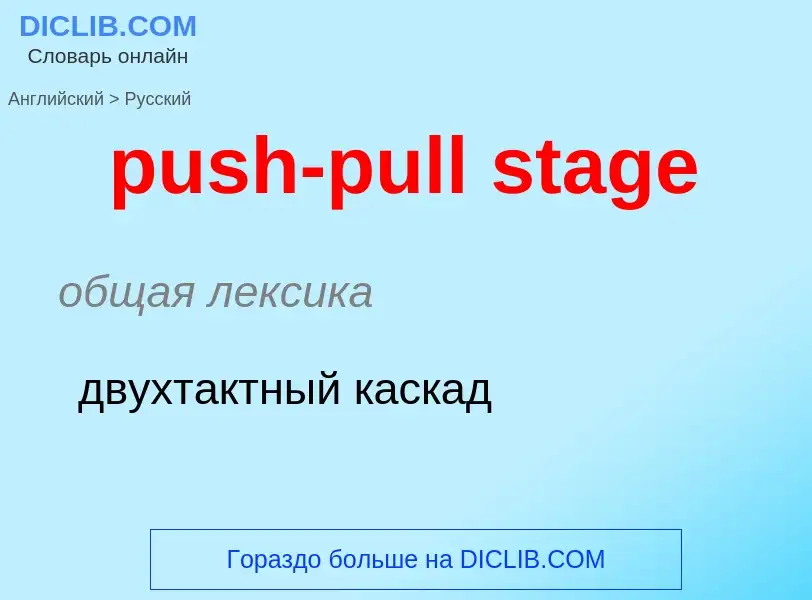Перевод и анализ слов искусственным интеллектом
На этой странице Вы можете получить подробный анализ слова или словосочетания, произведенный с помощью лучшей на сегодняшний день технологии искусственного интеллекта:
- как употребляется слово
- частота употребления
- используется оно чаще в устной или письменной речи
- варианты перевода слова
- примеры употребления (несколько фраз с переводом)
- этимология
push-pull stage - перевод на русский
общая лексика
двухтактный каскад
общая лексика
двухтактный усилитель
техника
усилитель двухтактный
[puʃ'pul]
общая лексика
вставной-вытяжной
двукратный
двухвинтовой
электроника
двухтактный
техника
пушпульный
прилагательное
электроника
двухтактный
пушпульный
Определение
Википедия
.png?width=120)
A push–pull amplifier is a type of electronic circuit that uses a pair of active devices that alternately supply current to, or absorb current from, a connected load. This kind of amplifier can enhance both the load capacity and switching speed.
Push–pull outputs are present in TTL and CMOS digital logic circuits and in some types of amplifiers, and are usually realized by a complementary pair of transistors, one dissipating or sinking current from the load to ground or a negative power supply, and the other supplying or sourcing current to the load from a positive power supply.
A push–pull amplifier is more efficient than a single-ended "class-A" amplifier. The output power that can be achieved is higher than the continuous dissipation rating of either transistor or tube used alone and increases the power available for a given supply voltage. Symmetrical construction of the two sides of the amplifier means that even-order harmonics are cancelled, which can reduce distortion. DC current is cancelled in the output, allowing a smaller output transformer to be used than in a single-ended amplifier. However, the push–pull amplifier requires a phase-splitting component that adds complexity and cost to the system; use of center-tapped transformers for input and output is a common technique but adds weight and restricts performance. If the two parts of the amplifier do not have identical characteristics, distortion can be introduced as the two halves of the input waveform are amplified unequally. Crossover distortion can be created near the zero point of each cycle as one device is cut off and the other device enters its active region.
Push–pull circuits are widely used in many amplifier output stages. A pair of audion tubes connected in push–pull is described in Edwin H. Colpitts' US patent 1137384 granted in 1915, although the patent does not specifically claim the push–pull connection. The technique was well-known at that time and the principle had been claimed in an 1895 patent predating electronic amplifiers. Possibly the first commercial product using a push–pull amplifier was the RCA Balanced amplifier released in 1924 for use with their Radiola III regenerative broadcast receiver. By using a pair of low-power vacuum tubes in push–pull configuration, the amplifier allowed the use of a loudspeaker instead of headphones, while providing acceptable battery life with low standby power consumption. The technique continues to be used in audio, radio frequency, digital and power electronics systems today.

.png?width=200)
![Typical transistor output stage of one channel of a 65 watt stereo amplifier from 1993. The 2 MOSFET push-pull output transistors (''FET2, FET4'') are bolted to the black [[heat sink]]. They are driven by transistors ''Q2, Q5, Q6,'' and ''Q7'' Typical transistor output stage of one channel of a 65 watt stereo amplifier from 1993. The 2 MOSFET push-pull output transistors (''FET2, FET4'') are bolted to the black [[heat sink]]. They are driven by transistors ''Q2, Q5, Q6,'' and ''Q7''](https://commons.wikimedia.org/wiki/Special:FilePath/Aura VA 100 Evolution 2 (4061759992) - closeup of output stage.jpg?width=200)
